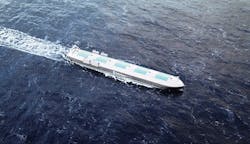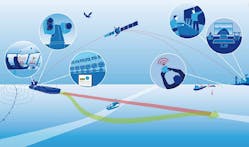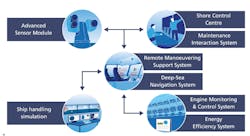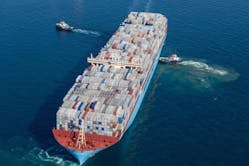When asked what an autonomous ship would look like Oskar Levander, vice president of innovation at Rolls-Royce Marine, said, “We are not constrained by the same limitations that a manned vessel has. What you end up with is a very lean and efficient machine.” Figure 1 shows a conceptual rendering of an autonomous ship.
One way that might look, says Levander, is a sort of hybrid. A ship on the open sea, traveling primarily straight ahead with little in its way, will be controlled by an onboard computer, with the occasional oversight of a land-based operator who may manage hundreds of different ships at once. As it comes to port, or enters a congested area, several things could happen. The remote operator could take full control, or a crew could boat out and board.
1. The Rolls-Royce concept of an autonomous ship.
There are a number of obvious advantages to going crewless. Designs will eliminate the quarters, mess, stairs, doors, and just about everything else people use. One upshot of this is loads of extra space, available for more cargo. Another is a more streamlined exterior. It even enables the weight to balance out nicely. Traditional ships have a lot of weight in the stern, thanks to the bridge. The lighter center is buoyant, bending upward and requiring heavy ballast, often in the form of water, that is hauled around for no other purpose than to keep the ship level. Take away the superstructure, redistribute the weight, and it will reduce the ballast needed.
Available space costs money on the ship. “It’s really only when you go fully unmanned that you can reduce all the systems,” says Levander. “When we add this all together, the reduced electrical consumption when we take out systems, the lower weight of the vessel, the lower wind resistance, we talk about a 10 to 15% fuel savings, for a typical cargo vessel.” And elimination of HVAC, food and water, and other life-sustaining systems is another advantage, reducing cost of the ship while increasing space.
First Ship
One version of an autonomous and zero emissions ship is planned to start in the latter half of 2018, shipping products from YARA’s Porsgrunn production plant to Brevik and Larvik in Norway. Autonomous and 100% electric, YARA Birkeland will be the world’s most advanced container feeder ship (Fig. 2).
2. Yara Birkeland is set to be the world's first all-electric, autonomous shipping container vessel when it launches in late 2018.
The vessel will be the world’s first fully electric container feeder. YARA’s new vessel will reduce NO and CO2 emissions and improve road safety by removing up to 40,000 truck journeys in populated urban areas.
YARA Birkeland will initially operate as a manned vessel, moving to remote operation in 2019 and expected to be capable of performing fully autonomous operations from 2020. The new zero-emission vessel will be a game-changer for global maritime transport contributing to meet the UN sustainability goals.
Kongsberg is responsible for development and delivery of all key enabling technologies on YARA Birkeland including the sensors and integration required for remote and autonomous operations, in addition to the electric drive, battery and propulsion control systems.
Even before the YARA Birkeland was proposed, a European research project published MUNIN, an acronym for Maritime Unmanned Navigation through Intelligence in Networks. The project’s intent was to develop the technology for an unmanned autonomous vessel.
The MUNIN research project developed a technical concept for the operation of an unmanned merchant ship and assessed its technical, economic and legal feasibility. This project envisages autonomous operation of an unmanned vessel only during a deep-sea voyage, not in congested or restricted waters, where tasks will still be performed by an on-board crew. Figure 3 shows a typical autonomous ship system that in communication and control between the ship and Shore Control Centre.
3. A typical autonomous ship command and control system. (Courtesy of Fraunhofer CML)
A primary aim for MUNIN was to mitigate the higher crew costs for slow steaming, which was its economic rationale. For example, a typical medium-sized bulk carrier can save about 50% of the cost for fuel with a 30% reduction in speed, even counting the extra voyage days at the slower speed. However, wages for a manned ship’s larger crew would offset much of these savings. Slow steaming also increases the societal challenge of providing attractive working conditions on long and slow intercontinental voyage.
A significant reduction of exhaust gas emissions from shipping is expected. It was also stipulated that an unmanned ship can be operated more efficiently with more advanced automatic energy management systems and improved routing and navigation. A large contribution to increased efficiency would result from the omission of accommodation superstructures.
Several functional modules support ship operation, shown in Fig. 4 and described below.
4. Onboard autonomous ship systems and the Shore Control Centre. (Courtesy of Fraunhofer CML)
Advanced Sensor Module
On an unmanned ship, sensors and sensor data processing are replacing the perceptions of the officer of the watch and thus are critical elements in the realization of autonomy. The Advanced Sensor Module is responsible for object detection and classification and environmental perception. It uses input data from infrared and visual spectrum cameras as well as radar and AIS data to detect objects and determine if they are a danger to the ship or if they need to be investigated further, e.g., to identify life rafts, flotsam, or dangers to navigations. It maintains a proper lookout for ship traffic and obstacles and monitors the environmental conditions in the vicinity of the ship. Sensor information is mainly used by the autonomous Deep Sea Navigation System but is also presented on an integrated situation display in the Shore Control Centre.
Deep Sea Navigation System
The Deep Sea Navigation System ensures that the ship follows its planned route within the allowable deviations given by the present operational envelope. Deviations can be caused by developing severe weather conditions or to avoid complex traffic situations. The ship’s particulars, its technical condition as well as the weather and traffic situation, are taken into account. In order to handle a ship on trans-oceanic voyages without on-board crew, the MUNIN project has introduced the Deep Sea Navigation System, which:
• Determines COL REG-obligations towards other ships and maneuvers the autonomous ship accordingly to the rules.
• Optimizes trans-oceanic voyage plans based on meteorological forecasts.
• Operates the ship safely in immediate and harsh weather conditions in accordance with the IMO weather guidance criteria.
The Deep Sea Navigation System can operate fully autonomously but also allows the Shore Control Centre operator to interact and thus to remotely control the ship.
Remote Maneuvering Support System
As an auxiliary for the Shore Control Centre and for the Deep Sea Navigation System, the Remote Maneuvering Support System aids in carrying out maneuvers for collision avoidance, while navigating in constrained waterways and in ports. By providing the anticipated ship motion trajectory, it is of essential importance to safe and efficient unmanned and autonomous ship operation. The Remote Maneuvering Support System provides calculations and displays for anticipated ship movements under constraints of maneuvering ability.
Engine Monitoring and Control System
The Engine Monitoring and Control System is an enhancement to existing ship automation and control systems. The main aim is to add more advanced condition-monitoring functionalities. Besides condition monitoring, adding of increased digital interfaces to the navigation systems and the Shore Control Centre are necessary to allow autonomous and unmanned operation of engine room and other technical systems. It allows very compact information to be sent to the Shore Control Centre with the possibility to request lower level measurements or intermediate calculations where needed.
Maintenance Interaction System
Without a crew, systems have to be redesigned or new processes put into place to ensure that the ship will operate without problems when it is at sea and that general ship maintenance can be performed without increasing the risk of technical failures. Existing ship systems need improved monitoring and support from the Shore Control Centre.
Energy Efficiency System
An unmanned and autonomous ship will have somewhat different engine and propulsion configurations compared to today‘s ships. The Energy Efficiency System seeks to use waste heat recovery and other available sources of energy. At the same time it compiles periodic reports on consumption, emissions and the ship performance to the Shore Control Centre.
Shore Control Centre
The Shore Control Centre acts as a continuously manned supervisory station for monitoring and controlling a fleet of autonomous ships. Most of the time, the ships are operating without any need for intervention from shore. In cases where the automated onboard systems cannot safely handle a situation, assistance will be provided. The limits for what is considered safe are customizable within the so-called operational envelope, setting navigational boundaries. The operational envelope will also include other factors such as visibility, wave height and traffic.
The MUNIN concept relies on the Shore Control Centre to handle complex situations as the onboard autonomous controller can only operate inside the defined constraints. This contributes to the balance between technological complexity and economic rationality, making this a viable concept.
Above, a typical container ship of today.





